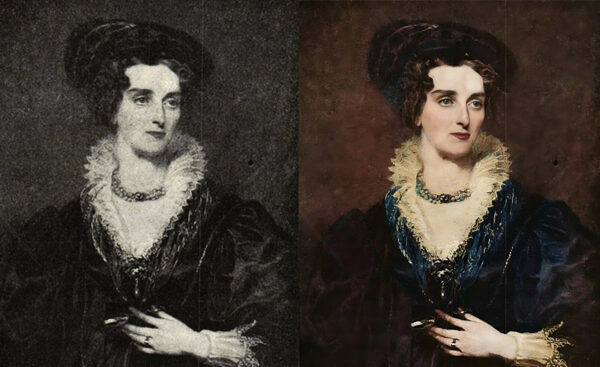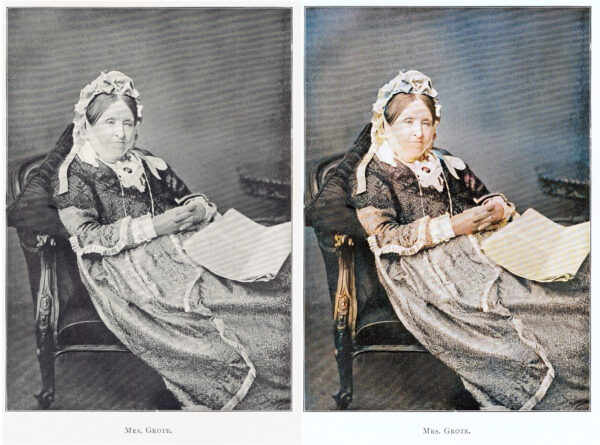Harriet Grote 1792 – 1878
(born Harriet Lewin)
Politician, author and arts patron.
1 July 1792 – 29 December 1878

Harriet Grote: a tribute by Martin Spychal
Harriet Grote was one of the most remarkable people in nineteenth-century Britain. A member of Britain’s wealthy upper middle class, her life encompassed two very different periods of women’s political and cultural activism. In the 1820s and 1830s she defied convention to place herself at the centre of London’s radical and progressive politics. During the 1840s and 1850s she used her global correspondence networks, wealth and cultural status to promote women in London’s theatre and art scenes. And by the 1860s she facilitated a new generation of ‘young people’ (as she called them), associated with the campaigns for women’s suffrage, education and social reform.
Early life and character
Harriet grew up in the comfortable surroundings of Ridgeway Castle near Southampton. Her father, Thomas Lewin, had funded the property with his earnings as a merchant for the East India Company. Harriet’s mother was Mary Lewin [née Mary Hale], who was connected by descent to the aristocratic Chaloner family of Guisborough.
Harriet’s father, aunt and family friends provided her with an early mentorship in politics, literature and music. Marked out from an early age by her intellect, she alarmed a string of governesses with what she fondly remembered as ‘propensities ‘unbecoming a young lady’. Throughout her life, people frequently remarked on her unwillingness to conform to gender stereotypes. The actor and writer Fanny Kemble remembered her as ‘very tall, square-built, and high shouldered’. The politician Richard Cobden described her as a ‘masculine lad[y]’ and a ‘rather strange looking personage’. Known for her distinctive fashion, Harriet often entertained visitors at her home wearing a coachman’s box coat and a man’s hat, equipped with a walking stick. At one dinner party she startled guests in a ‘bright brimstone-colored silk gown’ and a ‘white satin hat, with a forest of white feathers’.
Marriage and organisation of the ‘philosophic radicals’
In 1820 Harriet married George Grote, a self-educated scholar and partner in his father’s bank, Prescott and Grote (a predecessor of NatWest). She was easily George’s intellectual match. Together they cultivated a shared radical, utilitarian and atheist outlook. During the 1820s they lived between the City and London’s suburbs, becoming close friends with the leading utilitarians, Jeremy Bentham and James Mill. Grote organised regular reading groups and salons involving both men at her and George’s home in the City. These meetings were attended by the leading intellectual radicals of the day – or ‘philosophic radicals’ as they became known – of whom Grote (rather than her husband) was the chief organiser.
Connection to Bloomsbury
It was through this network that Grote developed a lifelong affiliation with Bloomsbury. In the 1820s her husband was a founding committee member of the radically secular London University (later University College, or UCL), and the Society for the Diffusion of Useful Knowledge. He was later a trustee of the British Museum, president of UCL and vice-chancellor of the University of London. Although Grote’s gender prevented her from playing an official role in these institutions, she was able to apply influence through her extensive political and social networks, contacts in the press and personal influence.
In 1827 she was present at the ceremony to mark the laying of the foundation stone of London University. Describing the event in Bloomsbury as a new ‘epoch in our domestic history’, she recorded that:
“The neighbourhood of Gower Street was alive with multitudes of spectators; all the windows which commanded a view of the procession, and even the house-tops, were lined with gazers … much sensation was occasioned by it [the opening of the University], not only in England but on the continent.”
During the 1850s and 1860s she wrote articles urging the expansion and reform of the British Museum. In 1862 she assisted George’s failed efforts to modify the University of London charter to allow Elizabeth Garrett and other female students to take degrees at the University. And she was an ardent campaigner for the maintenance of UCL’s secular principles – particularly during the 1866 controversy surrounding the proposed appointment of a Unitarian minister, James Martineau, to the Chair of Logic.
Westminster Politics during the 1830s
Grote developed many of her strategies for activism during the 1830s, when she was central to organising radical politics at Parliament. George was MP for London between 1832 and 1841, and in public emerged as a leader of the disparate, but initially sizeable, band of radicals and reformers in the Commons. Behind the scenes, however, Grote was the chief organising force of what she called the ‘popular party’. While she failed in her ultimate ambition of ‘bring[ing] destruction upon Whigs and Tories’, her innovative methods for influencing national politics were a clear example of unsung nineteenth-century female political leadership and a major challenge to convention at Westminster.
She organised politics initially from her and George’s Westminster residence, which played host to nightly meetings of MPs, thinkers and political families while Parliament was sitting. She cultivated a close inner circle of politicians, who strategised on weekends at their ‘country residence’ in Dulwich. She attended Parliament and watched debates with other women in the ‘Ventilator’, where she also met parliamentarians to discuss politics. She sought to dictate parliamentary tactics by writing articles in the Spectator (then a radical publication) and used her extensive social and political networks to act as a de facto radical whip. And, perhaps most extraordinarily, she oversaw the national campaign for the introduction of secret voting (the ‘ballot’) between 1836 and 1838.
Art Patron and the Society of Female Artists
Despite her best efforts, Grote became increasingly frustrated with MPs at Westminster, and their inability to effect real political change. She abandoned parliamentary politics on George’s retirement as MP in 1841. Following this she turned much of her attention to the patronage of music, theatre and art.
She did so initially by defying social convention and introducing the Austrian ballerina, Fanny Elssler, into London society. Elssler lived at the Grotes’ London home, where they became infatuated with her and agreed to act as surrogate parents for the dancer’s daughter while Elssler toured America. From 1845 Grote acted as the ‘patron, hostess and business manager’ for the renowned opera singer, Jenny Lind. Her oversight of Lind’s career helped to foster what became known as ‘Jenny Lind Fever’, which gripped England from 1847 and helped shape Lind into a global opera celebrity. A talented pianist and cellist in her own right, by the end of the 1840s Grote had established herself as one of London’s premier music patrons.
It was with Lind (now Jenny Lind Goldschmidt) that Grote worked during the 1850s to establish the Society of Female Artists. They established the society in the context of increasing dissatisfaction with the exclusionary policies of the Royal Academy, seeking to provide a dedicated space for exhibiting the work of women artists, and to support their professional training and publicise their work. Grote was the leading force behind the society. She secured ‘contributions and patronage’ from her ‘many friends’, organised (and also showed her own art at) its exhibitions, acted as press secretary and even claimed to have ‘played Jeremy Bentham’ in establishing the Society’s constitution. After several successful exhibitions, the Society began to face difficulties by the 1860s, when it re-formed as the Society of Lady Artists. In 1899 it changed names to the Society of Women Artists.
Connection to new generation of campaigners for women’s rights
Grote’s work with the Society of Female Artists and her extensive social and political network brought her into close contact with leading figures in the Langham Place Group from the late 1850s and later the Kensington Society. They included Barbara Leigh Smith Bodichon, Bessie Rayner Parkes, Millicent Fawcett and Emily Davies, as well as her niece, Sarah Lewin, who acted as the secretary for the Langham Place Group. Her long-term friendship with John Stuart Mill, which dated back to her activism in the 1820s, also brought Grote into regular contact with Mill’s stepdaughter, Helen Taylor.
Grote and Taylor talked of a ‘new period’ in British politics, which promised the realistic possibility of women’s political rights. Grote signed Bodichon and Taylor’s 1866 women’s suffrage petition, supported many of the leading campaigners, and also advised an older generation of political men and women to endorse the cause. At the age of 77, she made one of her first recorded public speeches at the London National Society for Women’s Suffrage, where she claimed she ‘had always advocated the enfranchisement of women’ and praised the ‘untiring zeal’ of the society. Grote was similarly supportive and active in the wider campaigns for women’s education, marriage, property and employment rights until her death. Had she been born a generation later, she observed with regret, she would have led the movement.

Dr Martin Spychal is a Senior Research Fellow at the History of Parliament working on the House of Commons 1832-1945 project. He is author of Mapping the State: English Boundaries and the 1832 Reform Act (University of London Press, 2024).
Further Reading
S. Richardson, ‘A Regular Politician in Breeches: The Life and Work of Harriet Lewin Grote’, in K. Demetrious (ed.), Brill’s Companion to George Grote and the Classical Tradition (2014)
M. T. Wium, ‘Jenny Lind, Harriet Grote and Elite Music Patronage in Early Victorian London’, Journal of the Royal Musical Association, 141 (2016), 283-302
Lady Eastlake, Mrs Grote: A Sketch (1880)
J. Hamburger, ‘Grote [née Lewin], Harriet’, Oxf. DNB, www.oxforddnb.com
M. Engelhardt, ‘Marie Taglioni, Ballerina Extraordinaire: In the Company of Women’, Nineteenth-Century Gender Studies (2010)
P. G. Nunn, Victorian Women Artists (1987)
C. Baile De Laperriere, The Society of Women Artists exhibitors 1855–1996: a dictionary of artists and their works in the annual exhibitions of The Society of Women Artists (1996)
K. Rix, ‘‘The first humble beginnings of an agitation’: the women’s suffrage petition of 7 June 1866’, Victorian Commons (2016)
Ann Dingsdale, ‘Generous and Lofty Sympathies’: The Kensington Society, The 1866 Women’s Suffrage Petition And the Development of Mid-Victorian Feminism (PhD, University of Greenwich, 1995)
S. Richardson, The Political Worlds of Women: Gender and Politics in Nineteenth Century Britain (2013)
K. Gleadle, Borderline Citizens: Women, gender and political culture in Britain, 1815-1867 (2009)
H. Grote, Collected Papers: In Prose and Verse 1842-1862 (1862)
H. Grote, The Philosophical Radicals of 1832 (1866)
H. Grote & B. Lumley, Reminiscences of Opera: Twenty Years of Her Majesty’s Theatre (1864)
H. Grote, The Personal Life of George Grote (1873)
H. Grote (ed.), Posthumous Papers: Comprising Selections from Familiar Correspondence (1874)
T. Lewin, The Lewin Letters: A Selection from the Correspondence & Diaries of an English Family, 1756-1884 (1909) Volume 1 Volume 2

